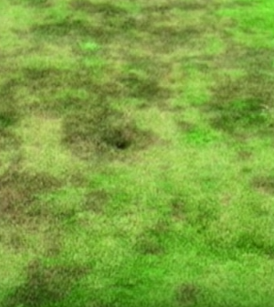All things being equal, it's my belief that avid golfers and plant pathologists normally don't have a whole lot in common. Coming from different worlds, their interests likely intersect with the frequency of a hole-in-one, at best.
However, in at least one instance when they did, the collaboration was as rewarding as watching a laser-like, fairway drive finding the green and coming to rest on the edge of the cup. And after an easy tap in, it was another crowd-pleasing win for science.
Researchers recently became interested in the short-cut grasses of several golf courses in the southeastern U.S. when superintendents from several states began noticing dark, stain-like patches that they've never seen before. And unable to identify them, course caretakers did not know which fungicides to use to treat these unsightly, blotchy areas (see photo, below right) that marred their once-pleasing golfing landscapes.
This foreign condition caught the attention of Dr. Young-Ki Jo, an associate professor in the Department of Plant Pathology and Microbiology at Texas A&M Agriculture and Life Sciences. Working with researchers, Dr. Jo determined that what they were seeing was a new, unnamed species of fungal disease.
At the same time "his counterpart Dr. Maria Tomaso-Peterson at Mississippi State University independently [was] examining samples of the infected grasses from various courses and, when they compared notes, agreed that the responsible pathogen was not known to scientists," according to an article in the Bryan-College Station Eagle, a Texas newspaper.

"If we don't know the biology of a fungus, there is no management protocol," stated Dr. Jo, in an on-camera interview with Texas A&M AgriLife Communications. It also became apparent that trying to simply guess which chemicals might work in treating the problem was an approach too inefficient and expensive, possibly costing thousands of dollars for unknown results. Therefore, "the golf course superintendents' first response is to be scared that the disease will take over the course."
Using DNA sequence comparisons, and then reviewing similar reports about blackened, short-cut Bermuda and Zoysia grasses from golf courses in Florida, Alabama, Texas and Tennessee, Drs. Jo and Tomaso-Peterson determined they had found a recurring turfgrass disease that was appearing in the south during the humid stretches of spring and fall.
"Field symptoms were conspicuous chocolate brown to black spots in turf of both species on golf course putting greens and fairways," the researchers wrote in their paper titled "Curvularia malina sp. nov. incites a new disease of warm-season turfgrasses in the southeastern United States," and published in August in the journal Mycologia. "Leaves of plants within these spots exhibited prominent, black eyespot lesions from which a darkly pigmented fungus was consistently isolated."
Drs. Jo and Tomaso-Peterson "researched the gene bank of the known fungi" before deciding to call it Curvularia malina, with malina, according to Dr. Jo, being the Sanskit word for "black."
Continuing on camera about the disease, "Luckily they don't completely kill the grasses," said Dr. Jo, whose Texas A&M bio lists him as holding a Masters in Entomology from Michigan State and a Ph.D in Plant Pathology from Ohio State. "The roots are still alive and the crown is still alive, so if you have proper treatments they will recover."
After conducting further tests, the research team was able to identify a fungicide that could treat Curvularia malina when it appeared. And as an added victory, it could even be sprayed preventatively on a course's suspect areas.
As many a duffer will tell you, several ingredients -- genial playing partners, good weather and a friendly bartender for that first icy beer at the 19th hole -- usually factor into a successful day at the course. But next time if you also recognize that the grass is greener on the other side of the fairway, go ahead, feel free to tip your cap to the club's plant pathologist.




